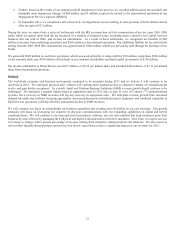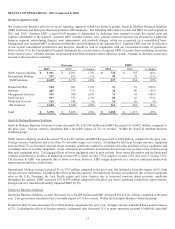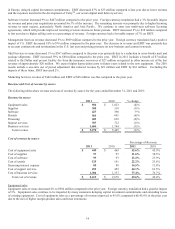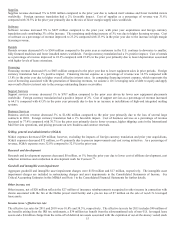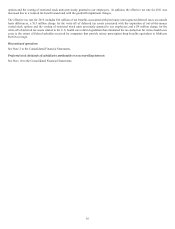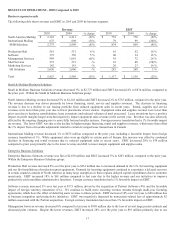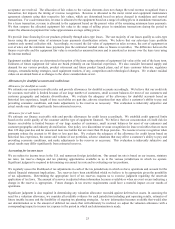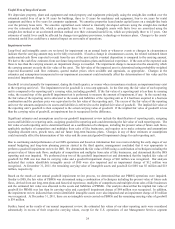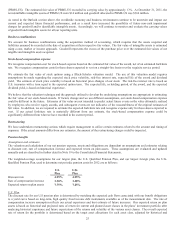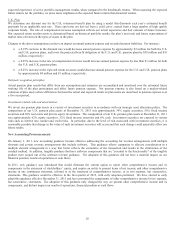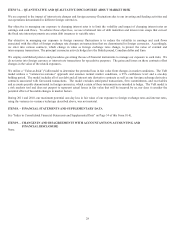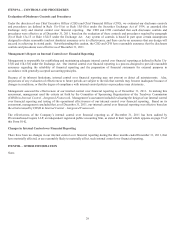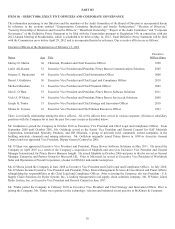Pitney Bowes 2011 Annual Report Download - page 39
Download and view the complete annual report
Please find page 39 of the 2011 Pitney Bowes annual report below. You can navigate through the pages in the report by either clicking on the pages listed below, or by using the keyword search tool below to find specific information within the annual report.
21
Net cash used in financing activities consisted primarily of dividends paid to common stockholders of $300 million, a net decrease in
commercial paper borrowings of $50 million and the repurchase of $100 million of our common stock.
2010 Cash Flows
Net cash provided by operating activities included $180 million and $43 million from decreases in finance receivables and accounts
receivables, respectively. Finance receivables declined as strong cash collections exceed the financing of new business and equipment
sales have declined. Accounts receivables declined primarily due to strong cash collections in excess of new billings. Cash flow also
benefited from the proceeds of $32 million from the unwinding of interest rate swaps and by $29 million due to the timing of
payments of accounts payable and accrued liabilities. Partially offsetting these benefits were restructuring payments of $120 million
and an increase in inventory of $12 million.
Net cash used in investing activities consisted primarily of the net purchase of investment securities of $122 million, capital
expenditures of $120 million for property, plant and equipment and rental equipment and related inventories and acquisitions of $78
million.
Net cash used in financing activities primarily included a net decrease in commercial paper borrowings of $171 million, stock
repurchases of $100 million and dividends paid to common stockholders of $302 million.
2009 Cash Flows
Net cash flow provided by operating activities included $207 million and $84 million from decreases in finance receivables and
accounts receivables, respectively, primarily due to lower sales volumes, and an increase in current and non-current income taxes of
$80 million due to the timing of tax payments. These cash inflows were partially offset by a reduction in accounts payable and
accrued liabilities of $127 million, primarily due to timing of payments, voluntary pension plan contributions of $125 million and
restructuring payments of $105 million.
Net cash used in investing activities consisted primarily of capital expenditures of $167 million for property, plant and equipment and
rental equipment and related inventories.
Net cash used in financing activities consisted primarily of dividends paid to common stockholders of $298 million, a net reduction in
debt of $242 million, and a net cash outflow associated with the issuance and redemption of preferred stock issued by a subsidiary of
$79 million.
Financings and Capitalization
We are a Well-Known Seasoned Issuer with the SEC, which allows us to issue debt securities, preferred stock, preference stock,
common stock, purchase contracts, depositary shares, warrants and units in an expedited fashion. We have a commercial paper
program that is an important source of liquidity for us and a committed line of credit of $1.25 billion to support our commercial paper
issuances. The line of credit expires in 2013. We have not experienced any problems to date in accessing the commercial paper
market. As of December 31, 2011, we have not drawn upon the line of credit.
During the year, we entered into two interest rate swap agreements with an aggregate notional value of $450 million to effectively
convert the fixed rate interest payments on our $450 million 4.875% notes due in 2014 into variable rates. Under the terms of these
agreements, we pay a weighted-average variable rate based on three-month LIBOR plus 305 basis points and receive fixed rate
payments of 4.875%.
In 2010, we unwound two interest rate swaps that effectively converted the fixed rate payments on the $250 million 5.6% notes due in
2018 into variable rates, and received $32 million, excluding accrued interest. This amount is being recognized as a reduction in
interest expense over the remaining term of the notes. The transaction was not undertaken for liquidity purposes, but rather to fix our
effective interest rate at 3.7% for the remaining term of the notes.
During the fourth quarter of 2012, $550 million of long-term debt is scheduled to mature. We are currently evaluating available
options, including using available cash to repay some of this debt. We may also refinance some or all of this amount with short-term
borrowings under our commercial paper program or through the issuance of long-term debt.
At December 31, 2011, there was no outstanding commercial paper. During the year, commercial paper borrowings averaged $138
million at a weighted-average interest rate of 0.22% and the maximum amount of commercial paper outstanding at any point in time
was $450 million. In 2010, commercial paper borrowings averaged $347 million at a weighted-average interest rate of 0.23% and the
maximum amount of commercial paper outstanding at any point in time was $552 million.
In January 2012, we contributed $85 million to our U.S. pension plan and $10 million to our foreign pension plans. We anticipate
making additional contributions of approximately $15 million and $20 million to our U.S. and foreign pension plans, respectively
during 2012. We will reassess our funding alternatives as the year progresses.



